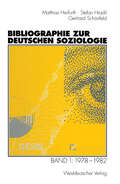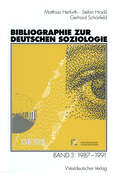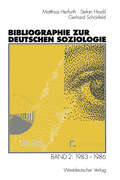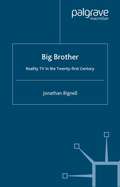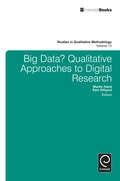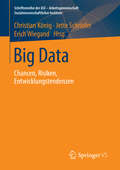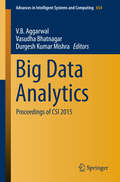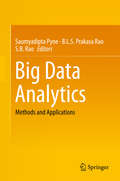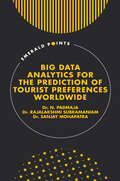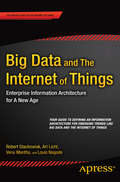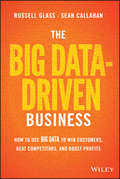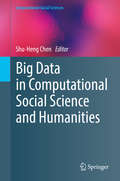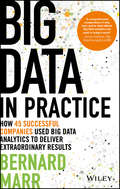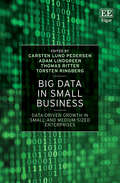- Table View
- List View
Biblical Perspectives on Leadership and Organizations
by J. Lee WhittingtonBiblical Perspectives on Leadership and Organizations links biblically-based principles to the study of organizational practices by examining topics including motives, meaningful work, and spiritual leadership from a biblical perspective integrated with findings from contemporary research.
Bibliographie zur deutschen Soziologie: Band 4: 1992 – 1995
by Matthias Herfurth Stefan HradilDiese Bibliographie - entstanden aus der Datenbank SOLIS (Sozialwissenschaftliches Literaturinformationssystem) - des Informationszentrums Sozialwissenschaften in Bonn enthält die soziologische Fachliteratur der Erscheinungsjahre 1992 bis 1995. In ihr werden ca. 14.250 selbständige und unselbständige Veröffentlichungen aus dem gesamten deutschsprachigen Raum nachgewiesen. Die Bibliographie ist in drei Abschnitte (Grundlagen und Methoden, Spezielle Soziologie, Sozialpsychologie) und insgesamt 29 Kapitel untergliedert. Mit dieser Veröffentlichung wird die Reihe soziologischer Bibliographien abgeschlossen, die mit den 1998 und 1999 erschienenen Bänden "1978 - 1982" (Band 1), "1983 - 1986" (Band 2) und "1987 - 1991" (Band 3) neu begonnen wurde und die bis auf die 1980 erschienene "Bibliographie zur deutschen Soziologie 1945 - 1977" zurückgeht. Die Bibliographie wird (neben der Kapitelgliederung) durch ein umfassendes Personenregister, ein Institutionenregister sowie durch ein zweistufiges Sachregister erschlossen, das sich auf den vom Informationszentrum Sozialwissenschaften entwickelten Thesaurus der sozialwissenschaftlichen Terminologie stützt und alle in ihm enthaltenen Sachgebiete berücksichtigt. Sie enthält ferner eine Liste aller ausgewerteten Zeitschriften.
Bibliographie zur deutschen Soziologie: Band 1: 1978–1982
by Matthias Herfurth Stefan Hradil Gerhard SchönfeldDiese Bibliographie - entstanden aus der Datenbank SOLIS (Sozialwissenschaftliches Literaturinformationssystem) - enthält die soziologische Fachliteratur der Erscheinungsjahre 1978 bis 1982. In ihr werden über 14.000 selbständige und unselbständige Veröffentlichungen aus dem gesamten deutschsprachigen Raum nachgewiesen. Die Bibliographie ist inhaltlich in drei Abschnitte (Grundlagen und Methoden, Spezielle Soziologie, Sozialpsychologie) und insgesamt 29 Kapitel untergliedert. Sie schließt an eine frühere Publikation gleichen Namens ("Bibliographie zur Deutschen Soziologie 1945 - 1977") an und bildet den ersten Band einer Folge gleichartiger Bibliographien, die in kurzen Abständen erscheinen und den Anschluß an das Hier und Heute herstellen werden. Die Bibliographie wird (neben der Kapitelgliederung) durch ein umfassendes Personenregister, ein Institutionenregister sowie durch ein zweistufiges Sachregister erschlossen, das sich auf den vom Informationszentrum Sozialwissenschaften entwickelten Thesaurus der sozialwissenschaftlichen Fachterminologie stützt und alle in ihm enthaltenen Sachgebiete berücksichtigt.
Bibliographie zur deutschen Soziologie: Band 3: 1987 – 1991
by Matthias Herfurth Stefan Hradil Gerhard SchönfeldDiese Bibliographie - entstanden aus der Datenbank SOLIS (Sozialwissenschaftliches Literaturinformationssystem) - besteht aus mehreren Bänden, die in rascher Folge erscheinen werden bzw. bereits erschienen sind (Band 1 und 2 sind Anfang 1998 herausgegeben worden, Band 3 ist in Vorbereitung wird in Kürze folgen). Sie enthält die soziologische Fachliteratur ab dem Erscheinungsjahr 1978 und schließt an eine frühere Publikation gleichen Namens ('Bibliographie zur Deutschen Soziologie 1945-1977') an. Im Band 1 (1978-1982) werden über 14.000 selbständige und unselbständige Veröffentlichungen aus dem gesamten deutschsprachigen Raum nachgewiesen. Der Band 2 umfaßt die Jahre 1983-1986 und enthält ca. 14.900 Literaturnachweise. Band 3 wird etwa 15.600 Nachweise enthalten. Jeder Band ist inhaltlich in drei Abschnitte (Grundlagen und Methoden, Spezielle Soziologie, Sozialpsychologie) und insgesamt 29 Kapitel untergliedert. Die Bibliographie wird (neben der Kapitelgliederung) durch ein umfassendes Personenregister, ein Institutionenregister sowie durch ein zweistufiges Sachregister erschlossen, das sich auf den vom Informationszentrum Sozialwissenschaften entwickelten Thesaurus der sozialwissenschaftlichen Fachterminologie stützt und alle in ihm enthaltenen Sachgebiete berücksichtigt.
Bibliographie zur deutschen Soziologie: Band 2: 1983–1986
by Matthias Herfurth Stefan Hradil Gerhard SchönfeldDiese Bibliographie - entstanden aus der Datenbank SOLIS (Sozialwissenschaftliches Literaturinformationssystem) - enthält die soziologische Fachliteratur der Erscheinungsjahre 1983 bis 1986. In ihr werden fast 15.000 selbständige und unselbständige Veröffentlichungen aus dem gesamten deutschsprachigen Raum nachgewiesen. Die Bibliographie ist inhaltlich in drei Abschnitte (Grundlagen und Methoden, Spezielle Soziologie, Sozialpsychologie) und insgesamt 29 Kapitel untergliedert. Mit dieser Veröffentlichung wird die Reihe soziologischer Bibliographien fortgesetzt, die mit der im Jahr 1997 herausgegebenen "Bibliographie zur deutschen Soziologie 1978 - 1982" neu begründet wurde und bis auf die 1980 erschienene "Bibliographie zur deutschen Soziologie 1945 - 1977" zurückgeht. Die Bibliographie wird (neben der Kapitelgliederung) durch ein umfassendes Personenregister, ein Institutionenregister sowie durch ein zweistufiges Sachregister erschlossen, das sich auf den vom Informationszentrum Sozialwissenschaften entwickelten Thesaurus der sozialwissenschaftlichen Fachterminologie stützt und alle in ihm enthaltenen Sachgebiete berücksichtigt.
Bichitra: The Making of an Online Tagore Variorum (Quantitative Methods in the Humanities and Social Sciences)
by Sukanta ChaudhuriThis book documents the creation of the Bichitra Online Tagore Variorum, a publicly accessible database of Rabindranath Tagore's complete works in Bengali and English totaling some 140,000 pages of primary material. Chapters cover innovative aspects of the site, all replicable in other projects: a hyperbibliography; a search engine and hyperconcordance working across the database; and a unique collation program comparing variant texts at three levels. There are also chapters on the special problems of processing manuscripts, and on planning the website. Early chapters take readers through the history of the project, an overview of Tagore’s works, and the Bengali writing system with the challenges of adapting it to electronic form. The name Bichitra, meaning "various" in Bengali, alludes both to the great variety of Tagore’s works and to their various stages of composition. Beyond their literary excellence, they are notable for their sheer quantity, the number of variant forms of a great many items, and their afterlife in translation, often the poet’s own. Seldom if ever has the same writer revised his material and recast it across genres on such a scale. Tagore won the Nobel Prize in 1913. By its value-added presentation of this range of material, Bichitra can be a model for future databases covering an author’s complete works or other major corpus of texts. It offers vastly expanded access to Tagore’s writings, and enables new kinds of research including computational text analysis. The “book of the website” shows in technical and human terms how researchers with interests in art, literature and technology can collaborate on cultural informatics projects.
Bicycle Utopias: Imagining Fast and Slow Cycling Futures (Changing Mobilities)
by Cosmin PopanBicycle Utopias investigates the future of urban mobilities and post-car societies, arguing that the bicycle can become the nexus around which most human movement will revolve. Drawing on literature on post-car futures (Urry 2007; Dennis and Urry 2009), transition theory (Geels et al. 2012) and utopian studies (Levitas 2010, 2013), this book imagines a slow bicycle system as a necessary means to achieving more sustainable mobility futures. The imagination of a slow bicycle system is done in three ways: Scenario building to anticipate how cycling mobilities will look in the year 2050. A critique of the system of automobility and of fast cycling futures. An investigation of the cycling senses and sociabilities to describe the type of societies that such a slow bicycle system will enable. Bicycle Utopias will appeal to students and scholars in fields such as sociology, mobilities studies, human geography and urban and transport studies. This work may also be of interest to advocates, activists and professionals in the domains of cycling and sustainable mobilities.
Bicycle Utopias: Imagining Fast and Slow Cycling Futures (Changing Mobilities)
by Cosmin PopanBicycle Utopias investigates the future of urban mobilities and post-car societies, arguing that the bicycle can become the nexus around which most human movement will revolve. Drawing on literature on post-car futures (Urry 2007; Dennis and Urry 2009), transition theory (Geels et al. 2012) and utopian studies (Levitas 2010, 2013), this book imagines a slow bicycle system as a necessary means to achieving more sustainable mobility futures. The imagination of a slow bicycle system is done in three ways: Scenario building to anticipate how cycling mobilities will look in the year 2050. A critique of the system of automobility and of fast cycling futures. An investigation of the cycling senses and sociabilities to describe the type of societies that such a slow bicycle system will enable. Bicycle Utopias will appeal to students and scholars in fields such as sociology, mobilities studies, human geography and urban and transport studies. This work may also be of interest to advocates, activists and professionals in the domains of cycling and sustainable mobilities.
The Big Bang and God: An Astro-Theology
by Chandra Wickramasinghe Theodore WalkerAs advanced by astronomer-cosmologist Sir Fred Hoyle, astronomy, biology, astrobiology, astrophysics, and cosmology converge agreeably with natural theology. In The Big Bang and God, these interdisciplinary convergences are developed by an astronomer collaborating with a theologian.
Big Brother: Reality TV in the Twenty-First Century
by J. BignellJonathan Bignell presents a wide-ranging analysis of the television phenomenon of the early twenty-first century: Reality TV, exploring its cultural and political meanings, explaining the genesis of the form and its relationship to contemporary television production, and considering how it connects with, and breaks away from, factual and fictional conventions in television. Relationships with surveillance, celebrity and media culture are examined, leading to an appraisal of the directions that television culture is taking in the new century. His highly-readable style is accessible to readers at all levels of Culture and Media studies.
Big Capital: Who Is London For?
by Anna MintonThe inside story of London's housing crisis, by the award-winning author of Ground ControlLondon is facing the worst housing crisis in modern times, with knock-on effects for the rest of the UK. Despite the desperate shortage of housing, tens, perhaps hundreds of thousands of affordable homes are being pulled down, replaced by luxury apartments aimed at foreign investors. In this ideological war, housing is no longer considered a public good. Instead, only market solutions are considered - and these respond to the needs of global capital, rather than the needs of ordinary people. In politically uncertain times, the housing crisis has become a key driver creating and fuelling the inequalities of a divided nation. Anna Minton cuts through the complexities, jargon and spin to give a clear-sighted account of how we got into this mess and how we can get out of it.
Big Data?: Qualitative Approaches to Digital Research (Studies in Qualitative Methodology #13)
by Martin Hand Sam HillyardThis volume seeks to address the emerging relationships between qualitative research and digital data. At the present time, ubiquitous digital data is altering the foci of research, the contexts in which research takes place, and the methods and tools available for qualitative research. Alongside new challenges and opportunities, there are many ways in which established qualitative methods are being used to situate and interpret digital phenomena. This book examines and engages with the ambivalence of digitization, illuminating the diverse ways in which researchers approach, negotiate, understand and interpret objects and practices of digital research. The chapters in this volume are organized around four key themes: researching impacts of digitization on social worlds; researching uses of digital data within social worlds; researching digital visualization of social worlds; researching with digital data and methods. The volume is designed to appeal to qualitative researchers seeking to study processes of digitization, adjust existing methodologies for digital worlds, and develop new ways of examining and using digital research.
Big Data: Chancen, Risiken, Entwicklungstendenzen (Schriftenreihe der ASI - Arbeitsgemeinschaft Sozialwissenschaftlicher Institute)
by Christian König Jette Schröder Erich WiegandDas Buch gibt einen Überblick über die aktuelle Nutzung von Big Data in verschiedenen Bereichen sowie die damit verbundenen Chancen und Risiken, stellt neue Studiengänge vor, die zum Umgang mit Big Data befähigen, und behandelt Datenschutzanforderungen und Normen, die bei der Nutzung von Big Data relevant sind. Big Data, also große, komplexe und schnelllebige Datenmengen, werden in der akademischen Sozialforschung, der Marktforschung und der amtlichen Statistik zunehmend analysiert, um relevante Fragestellungen zu beantworten. Die HerausgeberChristian König ist Referent im Institut für Forschung und Entwicklung in der Bundesstatistik des Statistischen Bundesamtes, Wiesbaden und Dozent für das Fach Wirtschaftsmathematik an der Verwaltungs- und Wirtschaftsakademie Wiesbaden e. V.Jette Schröder ist Projektberaterin bei GESIS – Leibniz-Institut für Sozialwissenschaften und Geschäftsführerin der Arbeitsgemeinschaft Sozialwissenschaftlicher Institute e. V. (ASI).Erich Wiegand ist Geschäftsführer des ADM Arbeitskreis Deutscher Markt- und Sozialforschungsinstitute e.V.
Big Data Analytics: Proceedings of CSI 2015 (Advances in Intelligent Systems and Computing #654)
by V. B. Aggarwal Vasudha Bhatnagar Durgesh Kumar MishraThis volume comprises the select proceedings of the annual convention of the Computer Society of India. Divided into 10 topical volumes, the proceedings present papers on state-of-the-art research, surveys, and succinct reviews. The volumes cover diverse topics ranging from communications networks to big data analytics, and from system architecture to cyber security. This volume focuses on Big Data Analytics. The contents of this book will be useful to researchers and students alike.
Big Data Analytics: Methods and Applications
by Saumyadipta Pyne B. L. S. Prakasa Rao S. B. RaoThis book has a collection of articles written by Big Data experts to describe some of the cutting-edge methods and applications from their respective areas of interest, and provides the reader with a detailed overview of the field of Big Data Analytics as it is practiced today. The chapters cover technical aspects of key areas that generate and use Big Data such as management and finance; medicine and healthcare; genome, cytome and microbiome; graphs and networks; Internet of Things; Big Data standards; bench-marking of systems; and others. In addition to different applications, key algorithmic approaches such as graph partitioning, clustering and finite mixture modelling of high-dimensional data are also covered. The varied collection of themes in this volume introduces the reader to the richness of the emerging field of Big Data Analytics.
Big Data Analytics for the Prediction of Tourist Preferences Worldwide (Emerald Points)
by Dr. N. Padmaja Dr. Rajalakshmi Subramaniam Dr. Sanjay MohapatraBig Data analytics and machine learning are being adopted in a range of industries – but how can these technologies be utilised and what can they offer to the tourism industry? In the process of their journeys and in their decision-making processes, people who travel contribute to the generation of a huge flow of data; all this information is a potential base for creating smart destinations and improving tourism organizations’ potential to customize their products and service offerings. The real execution of such inventive forms of data-driven value generation in tourism continues to be more restricted to the theory or used in a few exceptional cases. Big data and machine learning techniques in tourism persists as an unclear concept and a subject of investigation that necessitates closer analysis from an extensive range of field and research methods. Big Data Analytics for the Prediction of Tourist Preferences Worldwide tackles this challenge, exploring the benefits, importance and demonstrates how Big Data can be applied in predicting tourist preferences and delivering tourism services in a customer friendly manner. The authors provide theoretical and experiential contributions designed to see a wider adoption of these technologies in the tourism industry.
Big Data Analytics for the Prediction of Tourist Preferences Worldwide (Emerald Points)
by Dr. N. Padmaja Dr. Rajalakshmi Subramaniam Dr. Sanjay MohapatraBig Data analytics and machine learning are being adopted in a range of industries – but how can these technologies be utilised and what can they offer to the tourism industry? In the process of their journeys and in their decision-making processes, people who travel contribute to the generation of a huge flow of data; all this information is a potential base for creating smart destinations and improving tourism organizations’ potential to customize their products and service offerings. The real execution of such inventive forms of data-driven value generation in tourism continues to be more restricted to the theory or used in a few exceptional cases. Big data and machine learning techniques in tourism persists as an unclear concept and a subject of investigation that necessitates closer analysis from an extensive range of field and research methods. Big Data Analytics for the Prediction of Tourist Preferences Worldwide tackles this challenge, exploring the benefits, importance and demonstrates how Big Data can be applied in predicting tourist preferences and delivering tourism services in a customer friendly manner. The authors provide theoretical and experiential contributions designed to see a wider adoption of these technologies in the tourism industry.
Big Data and The Internet of Things: Enterprise Information Architecture for A New Age
by Robert Stackowiak Art Licht Venu Mantha Louis NagodeEnterprise Information Architecture for a New Age: Big Data and The Internet of Things, provides guidance in designing an information architecture to accommodate increasingly large amounts of data, massively large amounts of data, not only from traditional sources, but also from novel sources such everyday objects that are fast becoming wired into global Internet. No business can afford to be caught out by missing the value to be mined from the increasingly large amounts of available data generated by everyday devices.The text provides background as to how analytical solutions and enterprise architecture methodologies and concepts have evolved (including the roles of data warehouses, business intelligence tools, predictive analytics, data discovery, Big Data, and the impact of the Internet of Things). Then you’re taken through a series of steps by which to define a future state architecture and create a plan for how to reach that future state. Enterprise Information Architecture for a New Age: Big Data and The Internet of Things helps you gain an understanding of the following:Implications of Big Data from a variety of new data sources (including data from sensors that are part of the Internet of Things) upon an information architectureHow establishing a vision for data usage by defining a roadmap that aligns IT with line-of-business needs is a key early stepThe importance and details of taking a step-by-step approach when dealing with shifting business challenges and changing technology capabilitiesHow to mitigate risk when evaluating existing infrastructure and designing and deploying new infrastructureEnterprise Information Architecture for a New Age: Big Data and The Internet of Things combines practical advice with technical considerations. Author Robert Stackowiak and his team are recognized worldwide for their expertise in large data solutions, including analytics. Don’t miss your chance to read this book and gain the benefit of their advice as you look forward in thinking through your own choices and designing your own architecture to accommodate the burgeoning explosion in data that can be analyzed and converted into valuable information to drive your business forward toward success.
The Big Data-Driven Business: How to Use Big Data to Win Customers, Beat Competitors, and Boost Profits
by Russell Glass Sean CallahanGet the expert perspective and practical advice on big data The Big Data-Driven Business: How to Use Big Data to Win Customers, Beat Competitors, and Boost Profits makes the case that big data is for real, and more than just big hype. The book uses real-life examples—from Nate Silver to Copernicus, and Apple to Blackberry—to demonstrate how the winners of the future will use big data to seek the truth. Written by a marketing journalist and the CEO of a multi-million-dollar B2B marketing platform that reaches more than 90% of the U.S. business population, this book is a comprehensive and accessible guide on how to win customers, beat competitors, and boost the bottom line with big data. The marketplace has entered an era where the customer holds all the cards. With unprecedented choice in both the consumer world and the B2B world, it's imperative that businesses gain a greater understanding of their customers and prospects. Big data is the key to this insight, because it provides a comprehensive view of a company's customers—who they are, and who they may be tomorrow. The Big Data-Driven Business is a complete guide to the future of business as seen through the lens of big data, with expert advice on real-world applications. Learn what big data is, and how it will transform the enterprise Explore why major corporations are betting their companies on marketing technology Read case studies of big data winners and losers Discover how to change privacy and security, and remodel marketing Better information allows for better decisions, better targeting, and better reach. Big data has become an indispensable tool for the most effective marketers in the business, and it's becoming less of a competitive advantage and more like an industry standard. Remaining relevant as the marketplace evolves requires a full understanding and application of big data, and The Big Data-Driven Business provides the practical guidance businesses need.
The Big Data-Driven Business: How to Use Big Data to Win Customers, Beat Competitors, and Boost Profits
by Russell Glass Sean CallahanGet the expert perspective and practical advice on big data The Big Data-Driven Business: How to Use Big Data to Win Customers, Beat Competitors, and Boost Profits makes the case that big data is for real, and more than just big hype. The book uses real-life examples—from Nate Silver to Copernicus, and Apple to Blackberry—to demonstrate how the winners of the future will use big data to seek the truth. Written by a marketing journalist and the CEO of a multi-million-dollar B2B marketing platform that reaches more than 90% of the U.S. business population, this book is a comprehensive and accessible guide on how to win customers, beat competitors, and boost the bottom line with big data. The marketplace has entered an era where the customer holds all the cards. With unprecedented choice in both the consumer world and the B2B world, it's imperative that businesses gain a greater understanding of their customers and prospects. Big data is the key to this insight, because it provides a comprehensive view of a company's customers—who they are, and who they may be tomorrow. The Big Data-Driven Business is a complete guide to the future of business as seen through the lens of big data, with expert advice on real-world applications. Learn what big data is, and how it will transform the enterprise Explore why major corporations are betting their companies on marketing technology Read case studies of big data winners and losers Discover how to change privacy and security, and remodel marketing Better information allows for better decisions, better targeting, and better reach. Big data has become an indispensable tool for the most effective marketers in the business, and it's becoming less of a competitive advantage and more like an industry standard. Remaining relevant as the marketplace evolves requires a full understanding and application of big data, and The Big Data-Driven Business provides the practical guidance businesses need.
Big Data in Computational Social Science and Humanities (Computational Social Sciences)
by Shu-Heng ChenThis edited volume focuses on big data implications for computational social science and humanities from management to usage. The first part of the book covers geographic data, text corpus data, and social media data, and exemplifies their concrete applications in a wide range of fields including anthropology, economics, finance, geography, history, linguistics, political science, psychology, public health, and mass communications. The second part of the book provides a panoramic view of the development of big data in the fields of computational social sciences and humanities. The following questions are addressed: why is there a need for novel data governance for this new type of data?, why is big data important for social scientists?, and how will it revolutionize the way social scientists conduct research? With the advent of the information age and technologies such as Web 2.0, ubiquitous computing, wearable devices, and the Internet of Things, digital society has fundamentally changed what we now know as "data", the very use of this data, and what we now call "knowledge". Big data has become the standard in social sciences, and has made these sciences more computational. Big Data in Computational Social Science and Humanities will appeal to graduate students and researchers working in the many subfields of the social sciences and humanities.
Big Data in Practice: How 45 Successful Companies Used Big Data Analytics to Deliver Extraordinary Results
by Bernard MarrThe best-selling author of Big Data is back, this time with a unique and in-depth insight into how specific companies use big data. Big data is on the tip of everyone's tongue. Everyone understands its power and importance, but many fail to grasp the actionable steps and resources required to utilise it effectively. This book fills the knowledge gap by showing how major companies are using big data every day, from an up-close, on-the-ground perspective. From technology, media and retail, to sport teams, government agencies and financial institutions, learn the actual strategies and processes being used to learn about customers, improve manufacturing, spur innovation, improve safety and so much more. Organised for easy dip-in navigation, each chapter follows the same structure to give you the information you need quickly. For each company profiled, learn what data was used, what problem it solved and the processes put it place to make it practical, as well as the technical details, challenges and lessons learned from each unique scenario. Learn how predictive analytics helps Amazon, Target, John Deere and Apple understand their customers Discover how big data is behind the success of Walmart, LinkedIn, Microsoft and more Learn how big data is changing medicine, law enforcement, hospitality, fashion, science and banking Develop your own big data strategy by accessing additional reading materials at the end of each chapter
Big Data in Practice: How 45 Successful Companies Used Big Data Analytics to Deliver Extraordinary Results
by Bernard MarrThe best-selling author of Big Data is back, this time with a unique and in-depth insight into how specific companies use big data. Big data is on the tip of everyone's tongue. Everyone understands its power and importance, but many fail to grasp the actionable steps and resources required to utilise it effectively. This book fills the knowledge gap by showing how major companies are using big data every day, from an up-close, on-the-ground perspective. From technology, media and retail, to sport teams, government agencies and financial institutions, learn the actual strategies and processes being used to learn about customers, improve manufacturing, spur innovation, improve safety and so much more. Organised for easy dip-in navigation, each chapter follows the same structure to give you the information you need quickly. For each company profiled, learn what data was used, what problem it solved and the processes put it place to make it practical, as well as the technical details, challenges and lessons learned from each unique scenario. Learn how predictive analytics helps Amazon, Target, John Deere and Apple understand their customers Discover how big data is behind the success of Walmart, LinkedIn, Microsoft and more Learn how big data is changing medicine, law enforcement, hospitality, fashion, science and banking Develop your own big data strategy by accessing additional reading materials at the end of each chapter
Big Data in Small Business: Data-Driven Growth in Small and Medium-Sized Enterprises
This important book considers the ways in which small and medium-sized enterprises (SMEs) can thrive in the age of big data. To address this central issue from multiple viewpoints, the editors introduce a collection of experiences, insights, and guidelines from a variety of expert researchers, each of whom provides a piece to solve this puzzle.Contributions address the limitations faced by SMEs in their access to data and demonstrate that the key to overcoming this issue is to be aware of these limitations, to work within them, and to use them to think creatively about how to overcome obstacles in new ways. They discuss Artificial Intelligence, revenue blueprinting, GDPR compliance, and other key topics related to the relationships between SMEs and data. Offering ideas to inspire big data-driven success by SMEs making smaller investments, the book argues that there must be a place for “ordinary” data-driven journeys that are available to firms of any size.Stimulating further thought and action, Big Data in Small Business will be of great interest to academics, researchers, and practitioners in areas such as strategic management, organizational and innovation studies, marketing, and sales. The ideas and information in this book will help fill knowledge gaps related to important aspects of capabilities, functions, and transformations of big data that drive business growth.
Big Data Meets Survey Science: A Collection of Innovative Methods (Wiley Series in Survey Methodology)
by Craig A HillOffers a clear view of the utility and place for survey data within the broader Big Data ecosystem This book presents a collection of snapshots from two sides of the Big Data perspective. It assembles an array of tangible tools, methods, and approaches that illustrate how Big Data sources and methods are being used in the survey and social sciences to improve official statistics and estimates for human populations. It also provides examples of how survey data are being used to evaluate and improve the quality of insights derived from Big Data. Big Data Meets Survey Science: A Collection of Innovative Methods shows how survey data and Big Data are used together for the benefit of one or more sources of data, with numerous chapters providing consistent illustrations and examples of survey data enriching the evaluation of Big Data sources. Examples of how machine learning, data mining, and other data science techniques are inserted into virtually every stage of the survey lifecycle are presented. Topics covered include: Total Error Frameworks for Found Data; Performance and Sensitivities of Home Detection on Mobile Phone Data; Assessing Community Wellbeing Using Google Street View and Satellite Imagery; Using Surveys to Build and Assess RBS Religious Flag; and more. Presents groundbreaking survey methods being utilized today in the field of Big Data Explores how machine learning methods can be applied to the design, collection, and analysis of social science data Filled with examples and illustrations that show how survey data benefits Big Data evaluation Covers methods and applications used in combining Big Data with survey statistics Examines regulations as well as ethical and privacy issues Big Data Meets Survey Science: A Collection of Innovative Methods is an excellent book for both the survey and social science communities as they learn to capitalize on this new revolution. It will also appeal to the broader data and computer science communities looking for new areas of application for emerging methods and data sources.


